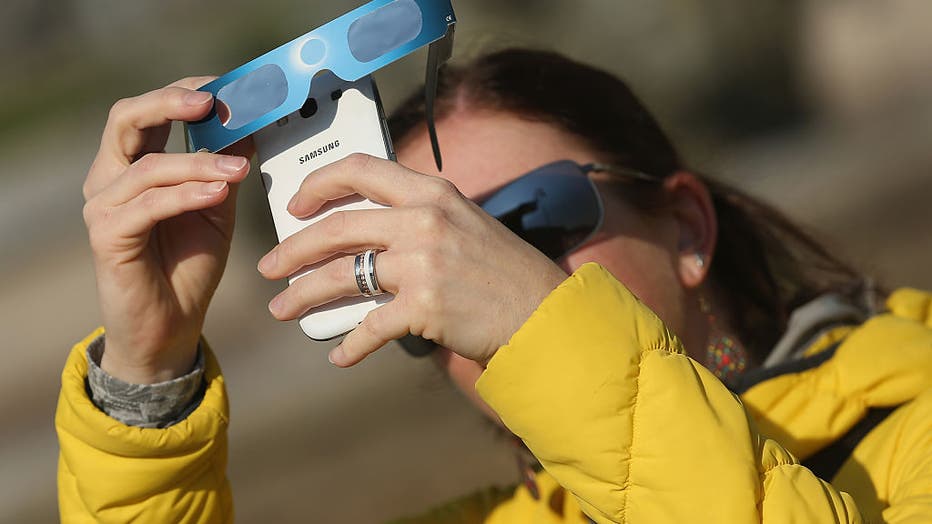How to take photos of the eclipse with your cellphone

NASA shares tips for viewing, photographing the eclipse
The total solar eclipse is just a few days away and the folks at NASA want to make sure you get the most out of it. Dr. Ashley Greeley, a NASA Heliophysicst, joined Good Day to talk about the best ways to view and take photos of the event.
DALLAS - If you don’t take a picture of the total solar eclipse on April 8, did it really happen?
Fortunately for you and all of the amateur photographers who will point their cellphone cameras skyward on Monday, NASA has tips for snapping a great photo of the rare celestial event.

BERLIN, GERMANY - MARCH 20: A woman uses special glasses and a smartphone to photograph a partial solar eclipse near the Brandenburg Gate on March 20, 2015 in Berlin, Germany. (Photo by Sean Gallup/Getty Images)
MORE: 2024 Great North American Eclipse
Eclipse Photography Tips
1. Use a solar filter
Be safe! You probably already know that looking directly at the sun with your eyes is dangerous. It can be dangerous for your camera lens too.
NASA recommends a lens filter specifically designed for solar imaging. You can buy solar filters online or at your local camera store for just a few bucks.
But if you are using a cellphone camera with a small lens, NASA Heliophysicist Dr. Ashley Greeley said your eclipse glasses will work as a filter.
"In totality, you can just take pictures of the sun and the corona without any protection. You can also look at it during those few minutes," she said. "But for the rest time, you'll need to use your solar viewer glasses over your cellphone camera lens because there are some delicate sensors in there that, unfortunately, would be damaged by the sun's rays just pointing it directly without any protection."
Greeley said eclipse glasses won't work for larger camera lenses, telescopes, or binoculars.
"You really need specialty lenses for that. Your solar viewer glasses aren't going to be big enough to fully cover the lenses," she said.

When it is safe to take your eclipse glasses off
Experts at the Perot Museum in Downtown Dallas letting eclipse viewers know when they need to wear eye protection during the total solar eclipse.
2. Use a tripod or telephoto zoom lens
A tripod will help stabilize your camera and prevent blurry images. Telephoto zoom lens attachments clip directly onto your phone over the existing lens and can give you a much clearer, magnified image.
If all you have is a camera with a built-in digital zoom, resist the urge to zoom in as far as you can go. The photo will more than likely come out grainy or blurry.
3. Focus elsewhere
Don't forget to turn your focus away from the sun, especially if you don't have any special camera equipment.
Point your camera toward friends and family as they enjoy the experience or photograph the landscape as it changes during the eclipse. Capture the eerie lighting and shadows around you.

North Texas couple to tie the knot on April 8
The couple?s wedding will be held at McKinney?s Bluebird Cottage on April 8, the day DFW lies in the path of the total solar eclipse. They?ve timed it out so totality is right after the ceremony.
4. Practice first
Practice taking pictures beforehand and play around with your camera's settings.
Your cellphone may not be able to auto-focus properly on the sun. You may need to focus manually, which can be done on most cellphones by tapping the screen and holding your finger on the sun to lock focus. Move your finger up or down to alter the exposure.
For DSLR cameras, NASA recommends using a fixed aperture of f/8 to f/16 and a shutter speed between 1/1000 to 1/4 second to find the optimal setting.
Also, practice photographing the moon at night to get a better idea of how your camera will work with the low light levels during totality.
5. Use delay and burst mode
Setting a 5-second delay will give your phone time to settle down and produce vibration-free pictures.
Then, as totality approaches, use burst mode to capture the last remnants of sunlight and the precise moment the sun is eclipsed.
6. Take a video
If you truly want to capture the experience, shoot a 5-minute video of before, during, and after totality.
Think about the once-in-a-lifetime experience and how you’ll want to remember it years from now.
Just be sure to hold your camera steady and avoid fast motions so the people watching it in the future don’t feel sick.

Eclipse buff, 105, excited to see his 13th eclipse
Retired engineer Laverne Biser is an eclipse aficionado. The 105-year-old has seen a dozen of them, and the total solar eclipse on April 8 will be his 13th.
For more tips and information, visit www.nasa.gov or download NASA's tip sheet.
In the end, just don’t let your desire to document the eclipse for yourself or social media keep you from actually experiencing it.




